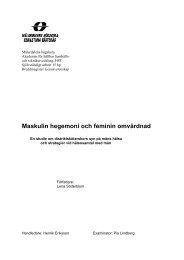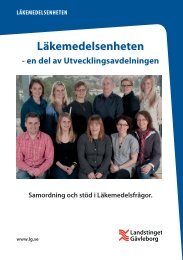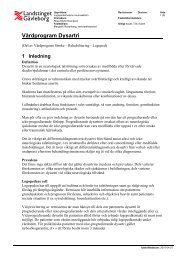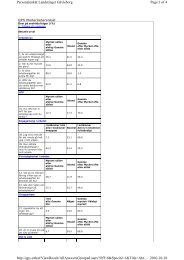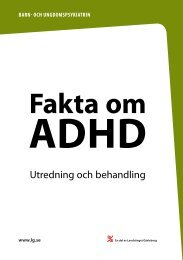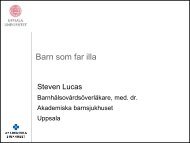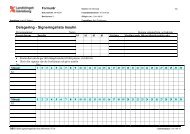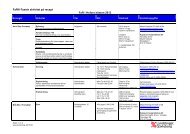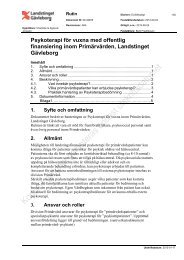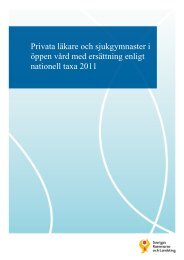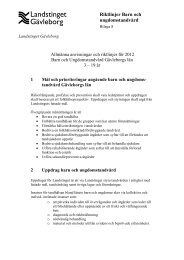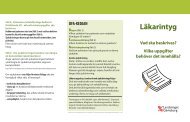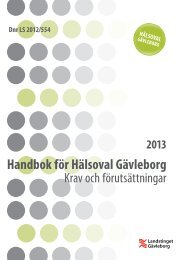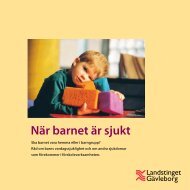à rlig rapport om forskningen i Landstinget Gävleborg 2010
à rlig rapport om forskningen i Landstinget Gävleborg 2010
à rlig rapport om forskningen i Landstinget Gävleborg 2010
- No tags were found...
Create successful ePaper yourself
Turn your PDF publications into a flip-book with our unique Google optimized e-Paper software.
DIVISION PRIMÄRVÅRDDoktorsexamenFörfattare:Titel:Bröms KristinaA Nationwide Study of Asthma and Allergy in Swedish Preschool Children: withSpecial Reference to Environment, Daycare, Prevalence, Co‐ocurrence andIncidenceInstitution: Uppsala universitet, Medicinska och farmaceutiska vetenskaps<strong>om</strong>rådet,Medicinska fakulteten, Institutionen för folkhälso‐ och vårdvetenskap,Allmänmedicin och klinisk epidemiologiNyckelord:Asthma, rhinitis, eczema, allergy, indoor environment, daycare centre,prevalence, incidence epidemiologyDisputation: <strong>2010</strong>‐05‐07, Brömssalen, ingång 11, Länssjukhuset, Gävle, 13:15 (Svenska)Opponent:Abstrakt:Åberg, Nils, Docent (Institutionen för kliniska vetenskaper, Sahlgrenskaakademien, Göteborgs universitet)Aim: The aim of this project was to study the age and sex specific occurrence ofatopic and non‐atopic asthma and other atopic manifestations in a nationwidesample of Swedish pre‐school children.Methods: All 70 allergen avoidance day‐care centres (AADC) with 84 sectionsand 140 matched ordinary day‐care centres with 440 sections in 62municipalities across Sweden were sampled. In 2000 the staff at each sectionresponded to a questionnaire on indoor and outdoor environment at thesection. In 2002 parents of 5,886 children attending the AADCs and ODCsresponded to a postal questionnaire regarding sympt<strong>om</strong>s indicating prevalentasthma, allergic rhinitis, eczema, and food, furred pet and pollen allergy andother data in their children. In 2007, parents of 4255 children responded to analmost identical follow‐up questionnaire.Results: The AADCs had far more strict rules than ODCs on furred pets andsmoking at h<strong>om</strong>e and on perfume use, and the indoor environment was better,owing to better cleaning. The age specific asthma prevalence was curvilinearwith a peak at age 3 of 11.4% among boys and 9.8% among girls. In addition theprevalence increased by municipality population density, a proxy for degree ofurbanisation. There was a highly significant co‐occurrence between all asthmaatopicmanifestations, but there was no evidence of ordered sequence ofmanifestation onset. The asthma incidence was highly dependent on presenceor absence of co‐occurrence variables. Given the variable mix in the presentstudy population, the annual asthma incidence ranged fr<strong>om</strong> 0.6% to 1.2%.Conclusions: AADCs had more strict rules and a better indoor environment thanODCs. The asthma prevalence was affected by age, sex and degree ofurbanisation. There was close co‐occurrence between all asthma and atopicmanifestations but no evidence of ordered sequence of onsets. The annualasthma incidence was strongly dependent of co‐occurrence conditions.32



